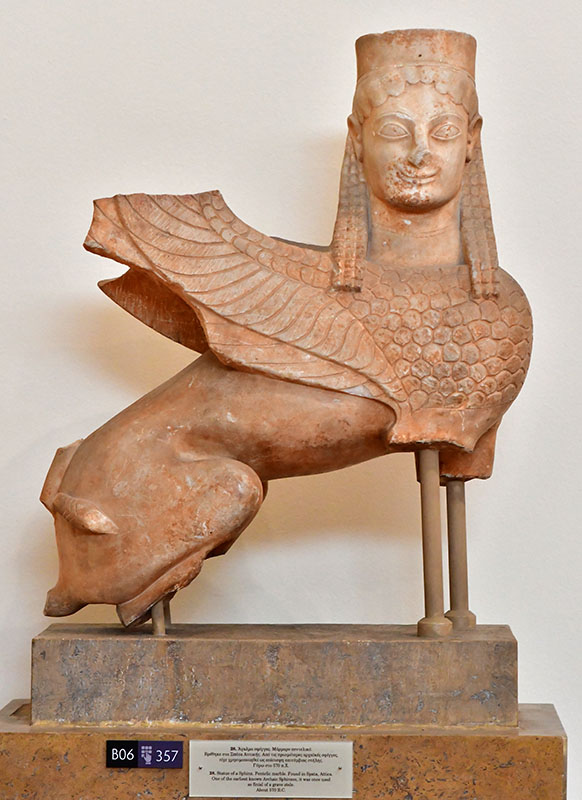Explore the must-see places on Santorini, from ancient Thera to Oia! Immerse yourself in the history, stunning views, and vibrant blue and white colors of this cinematic island.
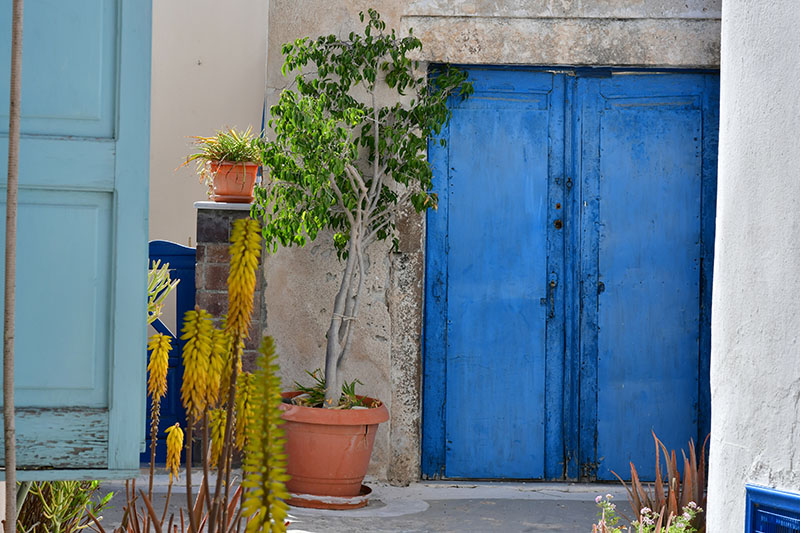
When we planed our trip, it was really hard to decide how much time we needed to spend on each island in Greece. Many people talked about spending a week on each one but I found that I needed 2,5 days to see everything I wanted to on Santorini without being rushed. These were long days but because I wasn’t into the beaches, boats and night life, I explored the island’s natural beauty, archeology and villages instead. Plan to spend more time here if you’re into the boat tours, wineries and beaches! Also, this island can be a challenge to visit for older folks since there is a lot of up and down action that can be hard on legs and feet.
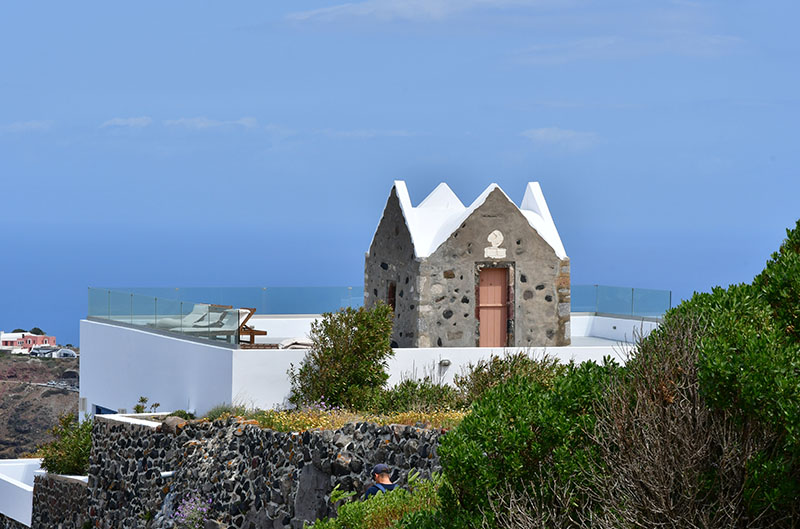
Brief history of Santorini: an archaeological journey
Some theorize that the end of the Minoan civilization and Ancient Thera (Santorini) volcanic formation is the lost Atlantis. The first written source for the myth of Atlantis comes from the Athenian philosopher Plato (427- 437 BC) but there is little evidence that Santorini is the lost Atlantis.
The first settlers arrived to the island around 3000 BC (Neolithic Period). They named the island “Strogili,” meaning “the round one” due to its original circular shape. Santorini flourished during the Minoan era, known for their advanced civilization centered on Crete (early Bronze Age – 2000 BC). The Akrotiri settlement, preserved by volcanic ash, is a prime example of the Minoan civilization. Here, archaeologists unearthed multi-story buildings with color frescoes, advanced drainage systems, and pottery, all mirroring Minoan culture that led to speculation about the lost city of Atlantis. Personally, I find it unlikely because the Minoan art on Crete looked immature in comparison to ancient Egypt, for example. And Atlantis is said to be an advanced civilization. The Minoan culture got destroyed after a catastrophic volcanic eruption that devastated the Aegean island of Thera- also called Santorini (Late Bronze Age – 1600 BC). Thera, perched on Mesa Vouno Mountain, became the island’s central settlement (Doric Era – 9th century BC onwards). The ruins include the Sanctuary of Artemis, the Agora (marketplace), the Royal Portico, and the Gymnasium.
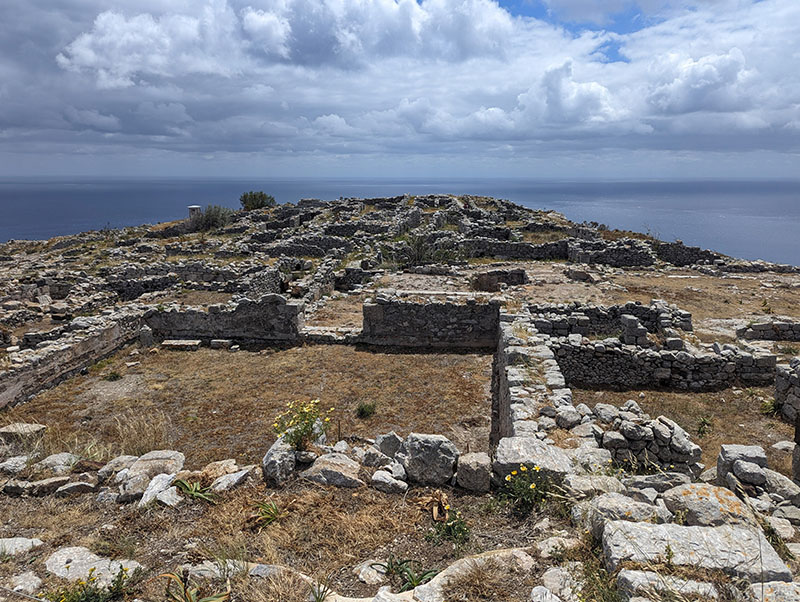
6 must-see places in Santorini:
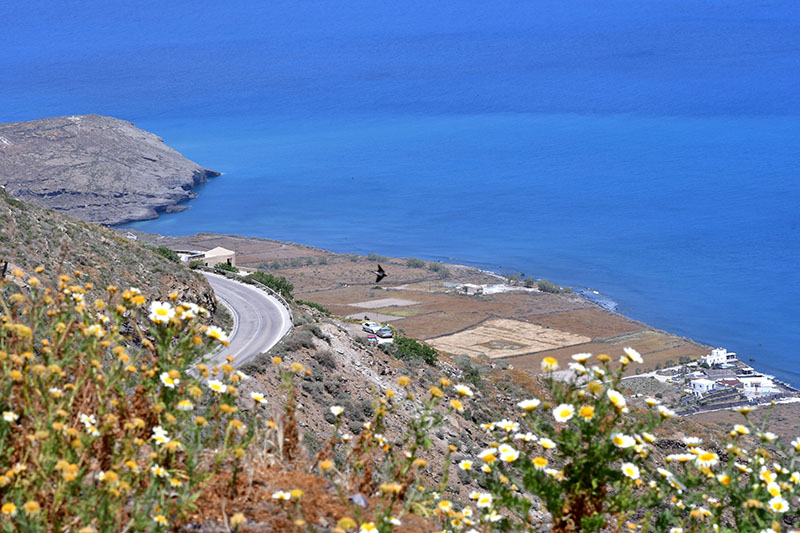
#1. Scenic trail
We walked from Fira to Oia through a scenic trail stretching across the mountains for 6.5 miles. The views were stunning! It was the most amazing place I saw on Santorini. The hike connects the two most popular destinations on the island – Fira and Oia. These are the largest traditional villages with whitewashed houses and blue domes. Many house caves overlooked deep turquoise-blue waters of the caldera. Wear good shoes and bring water and snacks to have a comfortable, 3-hour hike. The elevation is 1,069 ft, so you may feel a bit dizzy or tired walking there.
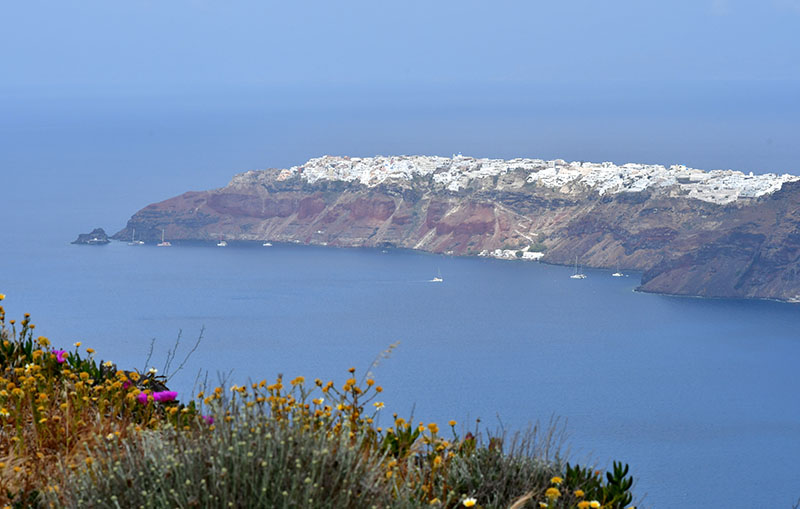
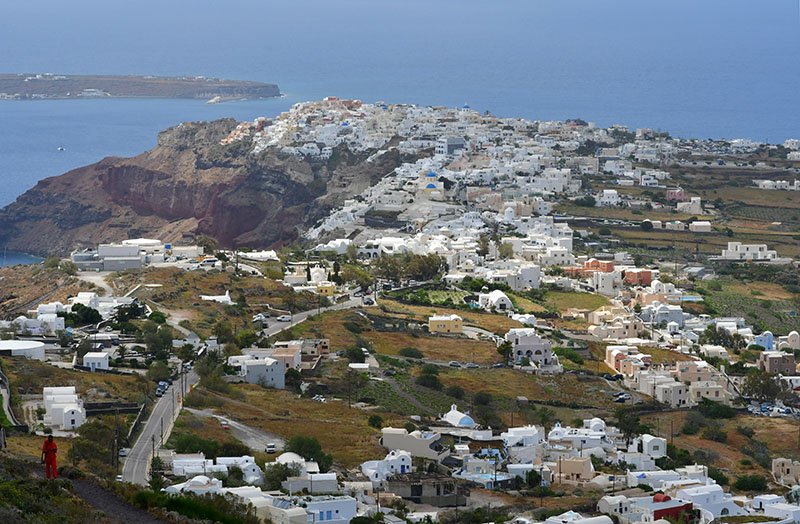
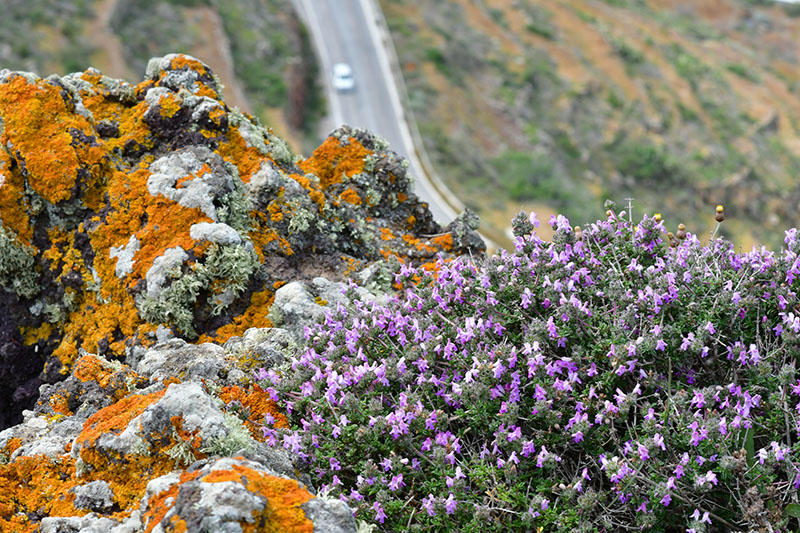
#2 Ancient Thera
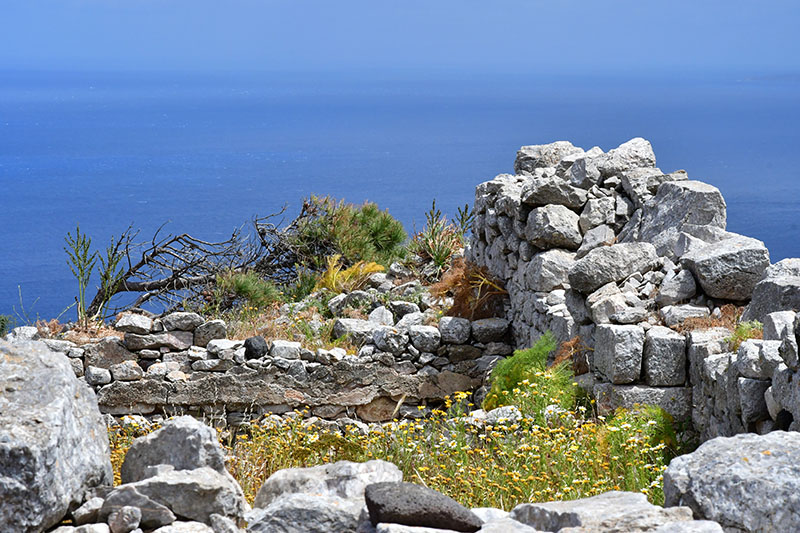
Situated on top of the mountain between Perissa and Kamari, Ancient Thera became the island’s central settlement. The volcanic eruption around 1600 BC reshaped the island, creating the iconic caldera and contributing to the decline of the Minoan civilization due to tsunamis. Following the eruption, Dorians from Sparta arrived around the 9th century BC, renaming the island “Thera” after their king. Today the Doric settlement is basically ruins that combines different architectural styles and epochs. All buildings were constructed of the local limestone of the mountain. By walking through the ruins located 396 m. above the sea level, you can enjoy amazing panoramic views of the island.
To get there, you can have an easy drive up to the Ancient Thera from Kamari. We had a steep climb to the top of the mountain walking from Perissa. It was quite long, difficult and unexpected but the views were fantastic!
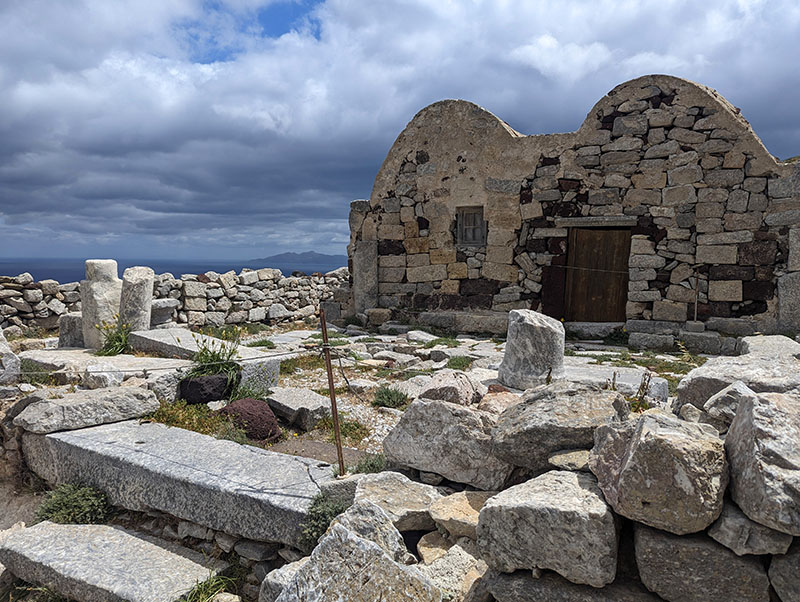
Sanctuary of Egyptian gods:
"During the Hellenistic times, a period of great receptivity to new gods and cults, the worship of eastern and Egyptian deities is spread across the Greek territory. In Thera, the Egyptian gods Serapis, Isis and Anubis become accepted in the early 3rd century B.C. and their cult is quickly integrated into the public and private religious life of the inhabitants of the island. The cult of the Egyptian triad of gods in Thera, which, in this period, belongs to the possessions of the Ptolemies, monarchs of the Hellenistic kingdom of Egypt, is closely associated with the presence and activity on the island of a large Ptolemaic garrison. A sanctuary in honor of the Egyptian gods is founded in the first half of the 3rd century B.C. The sanctuary consisted of an unusual outdoor construction, that is a terrace, constructed mainly with artificial earth fill, the two sides of which were defined by the rocky land.
We can see the rock-cut part of the sanctuary today, with niches for votive offerings on one side and a bench for the placement of cult statues on the other. Two cisterns placed next to the sanctuary provided "sacred water" the necessary for worship."
Maya Efstathiou, archaeologist.
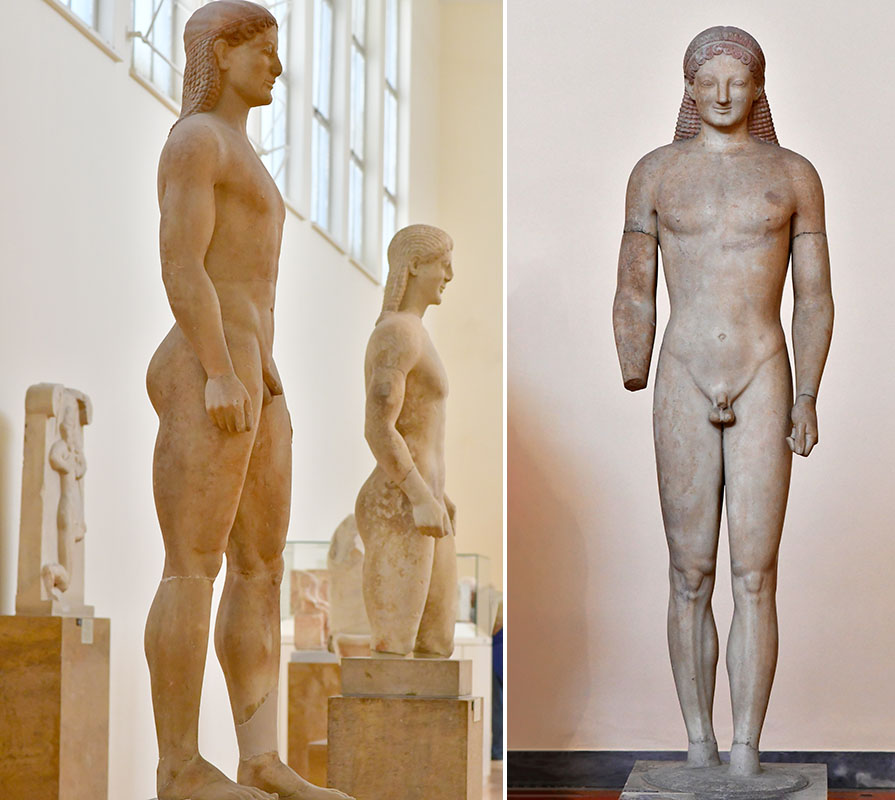
Sanctuary of Apollo Karneios:
The Sanctuary of Apollo was a cult center erected around the 7th c. B.C. The Karneia was his annual festival. The cult of Apollo Karneios, God of the Dorians, existed in Ancient Thera in antiquity. There’s not much to see but the rocks on the ground that used to be the sanctuary with the temple, gates and other buildings. The Apollo of Thera is the best found statue dating from the 6 BCE. There was a basilica built on the ruins of the temple, around the 6th century A.D, which destroyed the the upper structure of the temple.
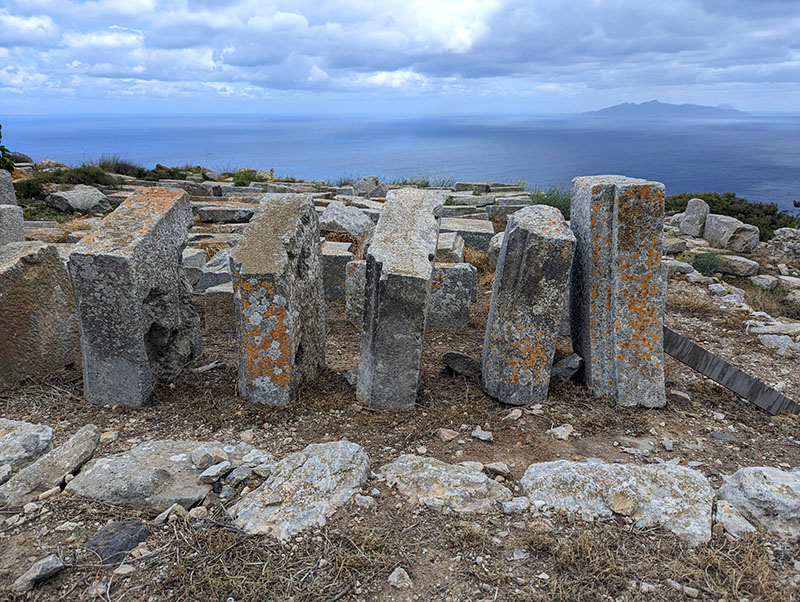
Other buildings:
There were other buildings and constructions in this place including the structure to worship the Egyptian gods, the theatre (the 2nd c. B.C.), the Stoa at the agora (the 3d c BC) , Gymnasium of the Ephebes, the open-air sanctuary Temenos of Artemidoros (3d c BC), and the church of Agios Stefanos- early Christian Basilica from 8th or 9th c. A.D. http://odysseus.culture.gr/h/3/eh352.jsp?obj_id=2454
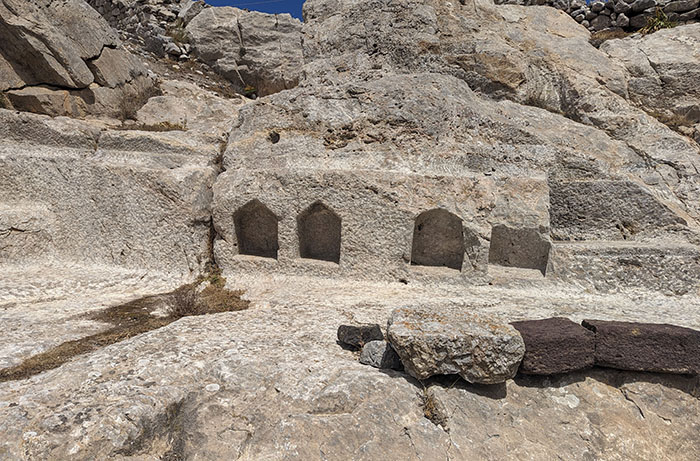
There was also the public building built during the Hellenistic times but re-structured during the Roman period. There was a low stone bench with special openings along the sides of its walls. A drain, carrying water into the sewer, ensured its cleaning. The public baths were probably constructed in the mid 2nd century A.D. The baths’ floor rested on stone supports forming a hollow underground space with a burning fire. The hot air was circulating under the floor and within the pipes built into the vertical walls of the room. During the Roman times, public baths were a popular meeting place.
The “exedrae”, three buildings in the form of a temple, date to the Roman times (1st-2nd c. A.D.). Built in a line, they housed statues of citizens that belonged to prominent families of Thera and were honored by the city. There are several inscribed bases of the statues with different names in existence today.
You can buy a single ticket to visit or a combined one that includes some local archeological museums.
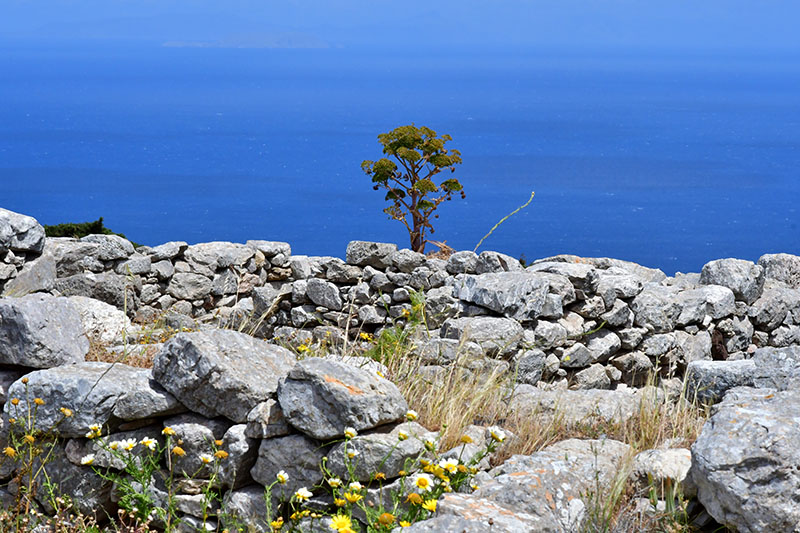
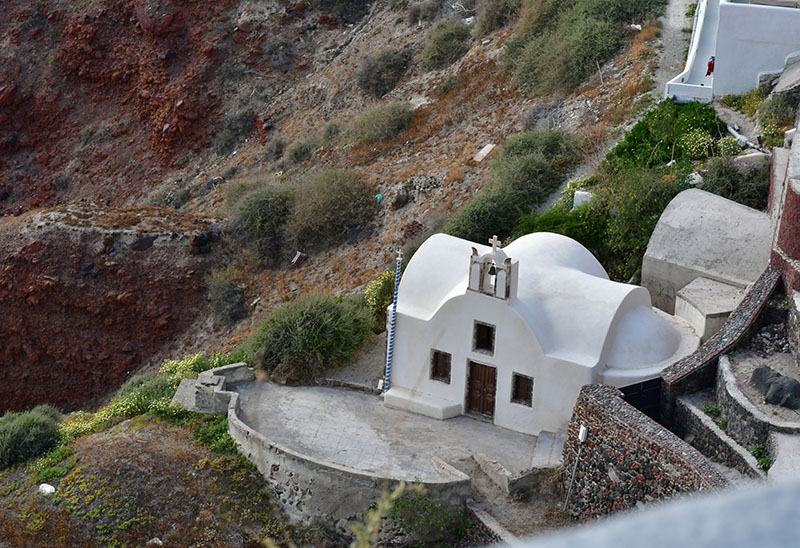
#3 Oia
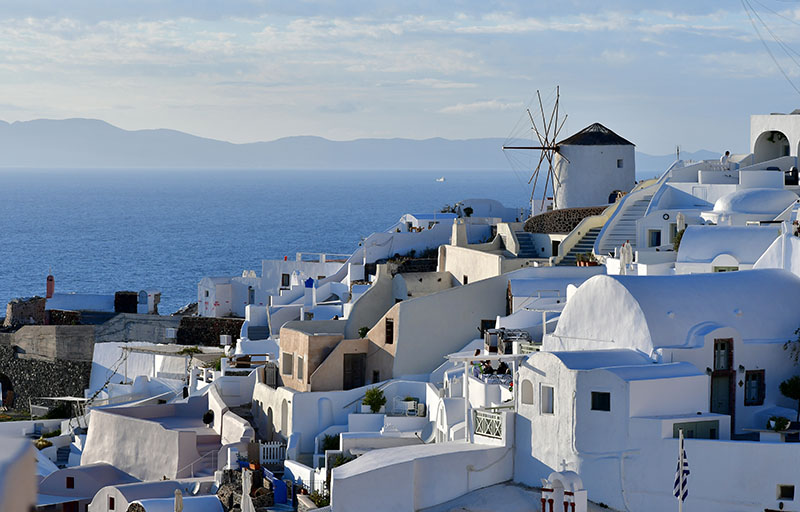
This is the largest and most beautiful village on the island that you must visit! It’s also very commercial with many shops, restaurants and activities in the area. The village is situated above a cliff at about 150 m (500 ft) elevation, overlooking the volcano and deep blue water. The views and sunsets are spectacular! The bus station is available with regular service to other parts of Santorini. Also, depending on your interest you can take an excursion boat for a trip around the island or a ferry to Therasia.
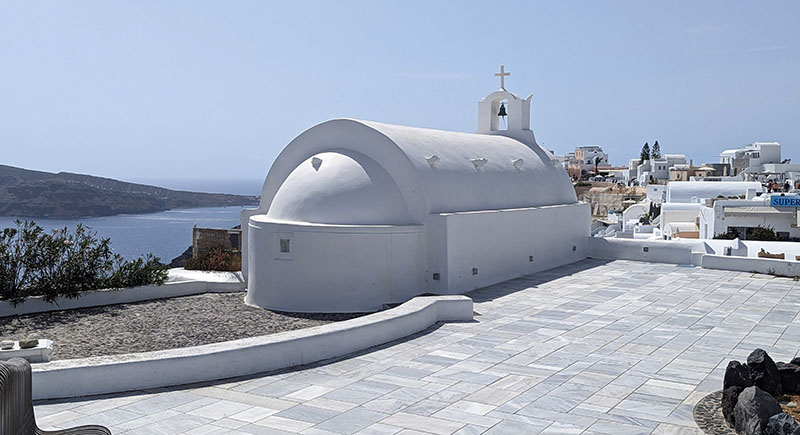
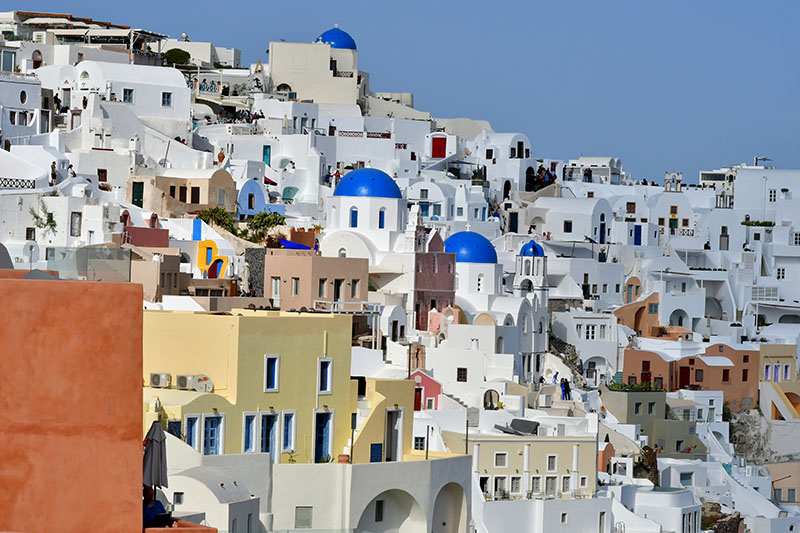
#4 Fira
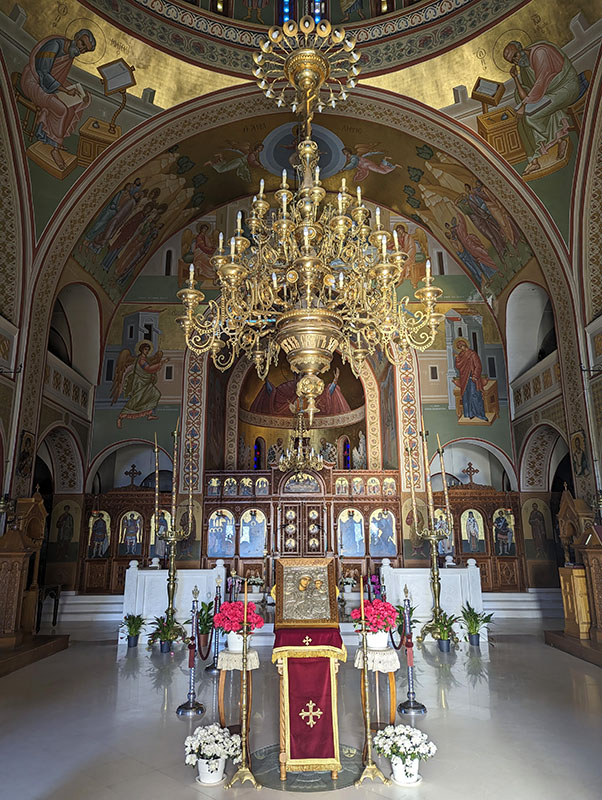
Centrally located, Fira offers stunning views of the caldera with some upscale shopping, beautiful Byzantine church, and walkable alleys. We stayed in Fira, which was a short taxi drive from the airport. Later we found out that the local bus was also available to get to the village.
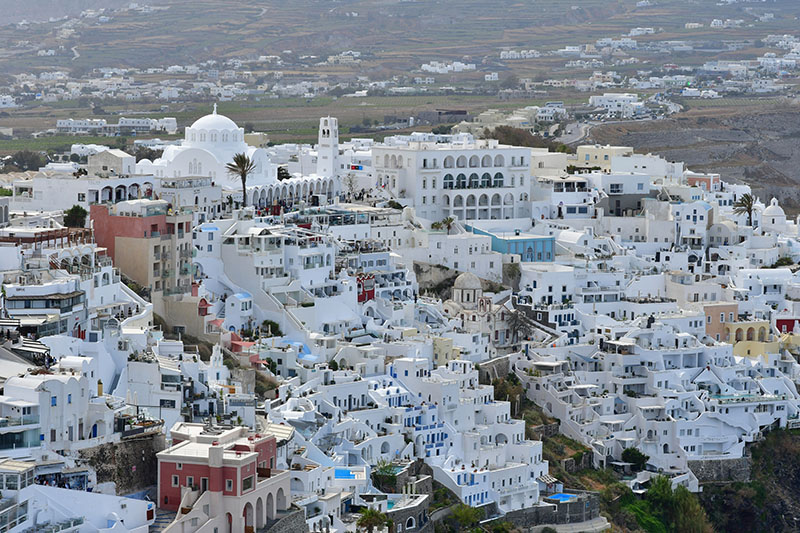
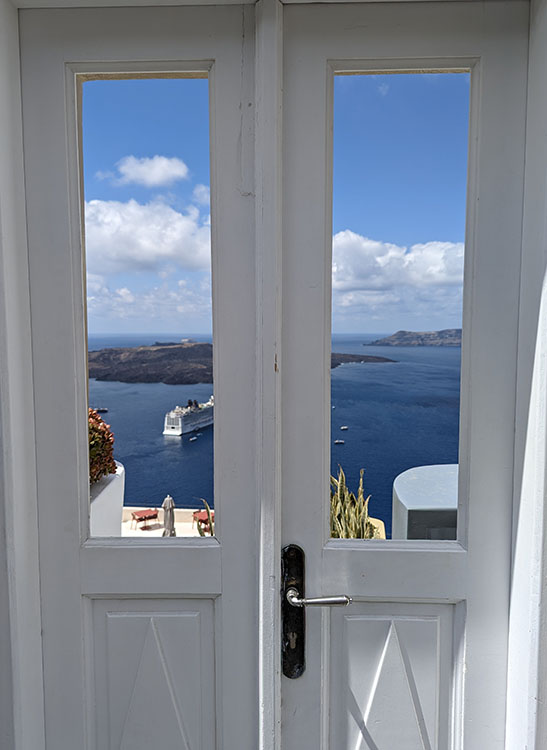
Santorini’s color scheme of white buildings and blue domes
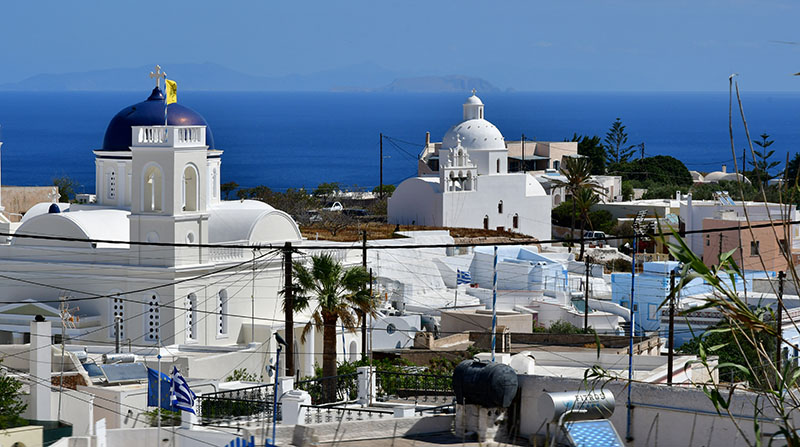
Color scheme:
The iconic white and blue color scheme on Santorini’s buildings isn’t rooted in ancient times. It became widespread after the fall of the Greek military junta in 1974. The white reflects the Aegean sunlight, while the blue symbolizes the sea. This color combination was believed to inspire patriotism as the Greek flag is also blue and white.
Also, the white color reflects a lot of the sunlight, keeping the interiors cooler during hot summers. This was crucial before modern air conditioning. Historically, a whitewash made with lime was used to paint the buildings. Limewash has natural disinfectant properties, which may have helped combat the spread of diseases like cholera during outbreaks in the early 20th century.
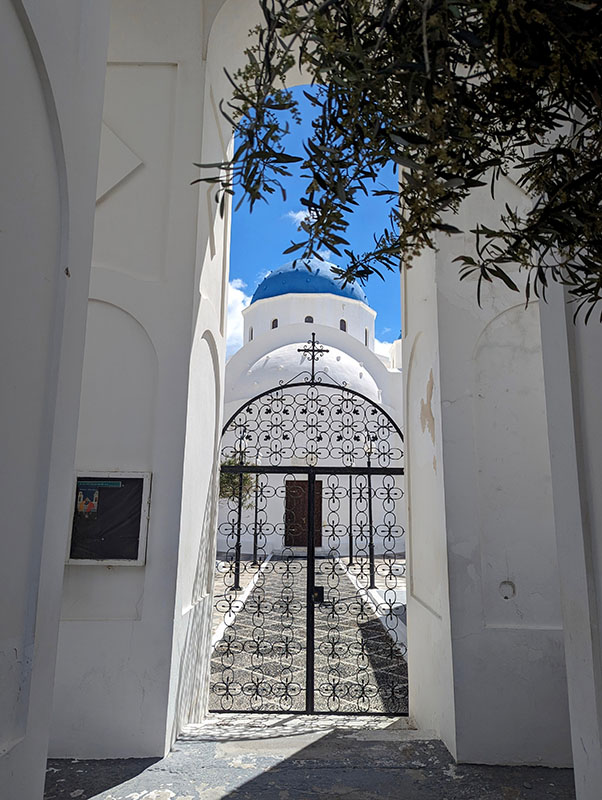
The design and construction:
Many traditional Santorini dwellings are cave houses, built directly into the volcanic cliffs. This provided natural insulation and protection from the elements. The cave walls themselves are often light-colored volcanic rock, further contributing to the overall white aesthetic. Santorini’s architecture falls under the Cycladic architectural style, common throughout the Aegean islands. These buildings have cubic shapes, minimal windows, flat roofs as terraces and balconies, maximizing usable space.
Building materials traditionally included volcanic rock and ash, timber and clay. While modern construction methods and materials are used today, the traditional whitewashed Cycladic style remains a defining characteristic of Santorini’s architecture.
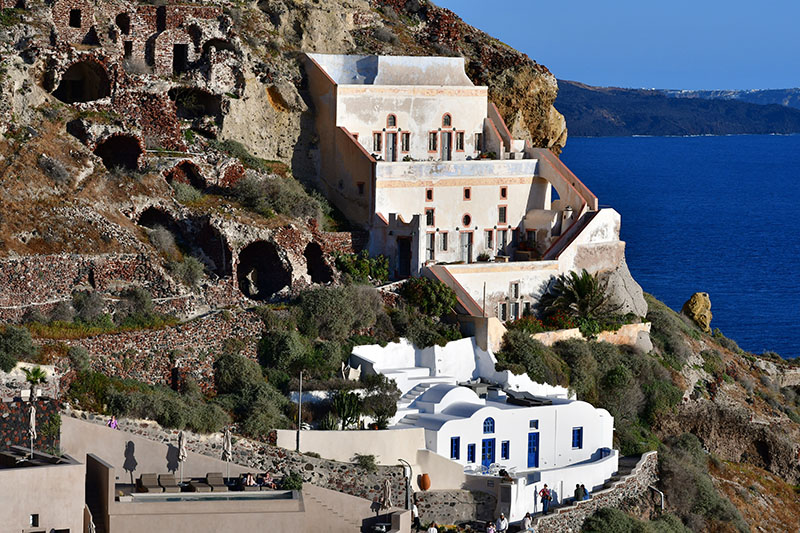
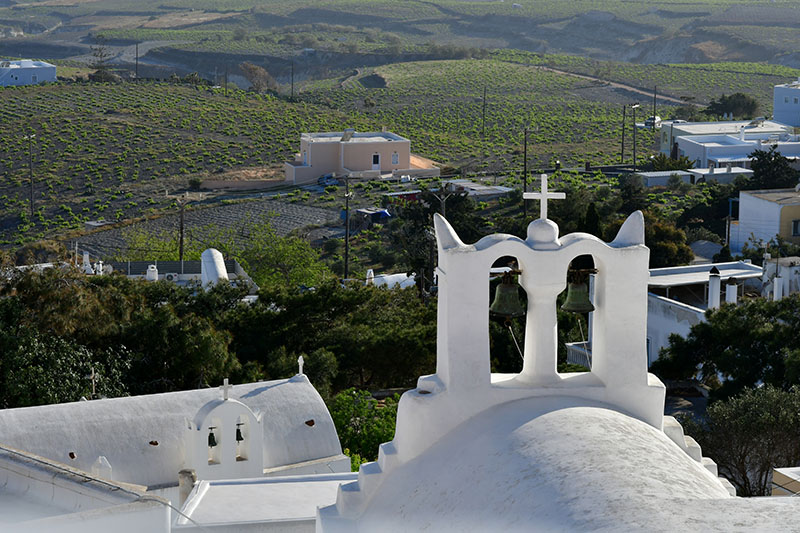
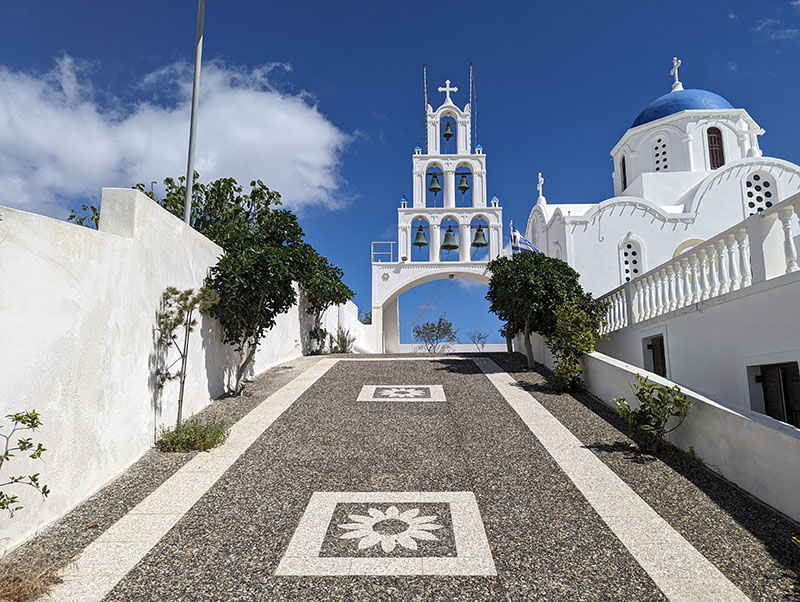
#5 Village of Megalochori
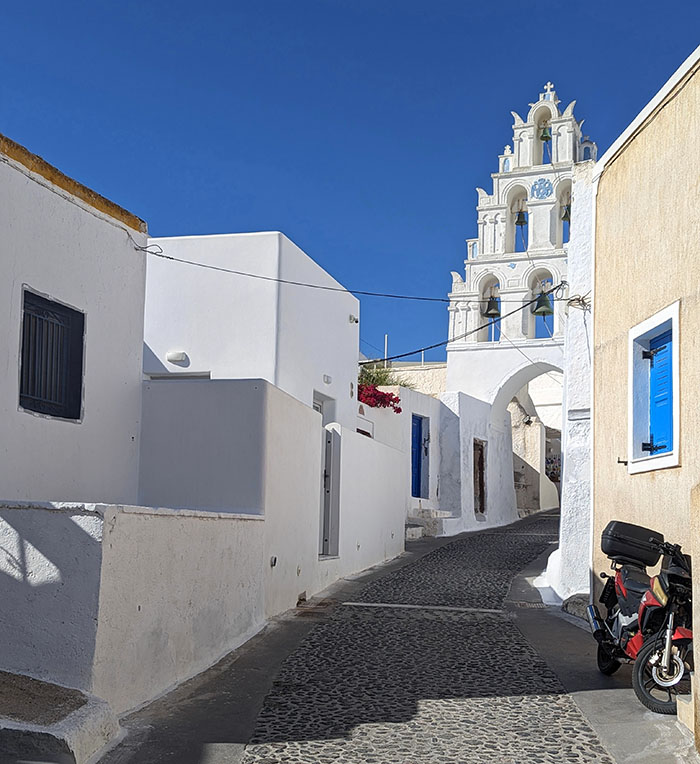
When you drive through the island from one major town to the next, it looks like a half-abandoned land with some distant white buildings scattered throughout fields of rock and tiny flowers. So, if you’d like to discover untouched settlements on the island, visit small villages like Akrotiri – the site of a Cycladic Bronze Age settlement or Pyrgos and Megalochori. These are not commercial, tiny villages with blue-domed Byzantine churches and whitewashed houses. Mesa Gonia or “the ghost village” is now abandoned village that used to be famous for wineries. We walked to some villages and took a bus to others. All churches were closed there for some odd reason.
Megalochori reminded me of the Tatooine from Star Wars because it was so untouched by our civilization. This village itself is a fairly short walk in a labyrinth of alleys, whitewashed houses and blue-domed churches with bell towers. The village had very few wondering tourists and some beautiful views of the caldera. There were two churches (Agios Nikolaos and Our Lady of Plaka) built into the rock there. Although there were some prehistoric settlements, the village took shape in the 17th century when wealthy merchants and land owners built the village with high walls and reinforced doors to protect themselves from pirates. It’s a place for vineries. There are two beaches- Plaka and Thermi that have no car access. It’s about 9 km away from Fira.
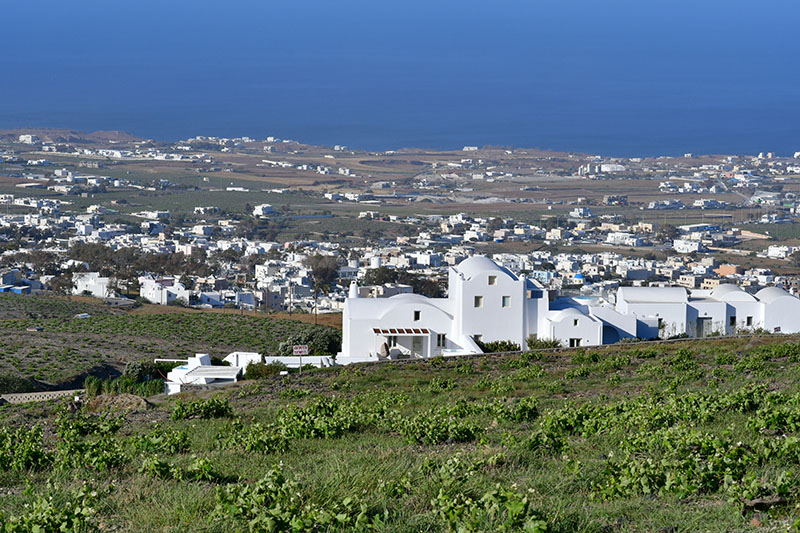
#6 Village of Pyrgos
Pyrgos was a monastery until the arrival of the Venetians in the 13th century. Venetians arriving on Santorini transformed the monastery into a fortified hamlet, one of five on the island, for defense against pirates. A central tower surrounded by thick and tall walls formed the heart of the settlement, with houses built tall within these walls for extra protection.
A former capital of the island, Pyrgos retains a strong character of a medieval village with narrow, labyrinthine streets, remnants of fortified walls, and hidden passageways. Despite its central location on Santorini that’s about 7.5 km from Fira, Pyrgos has been relatively untouched by the extensive development and commercialization seen in other parts of the island. Although it was severely damaged like other villages in 1956 earthquake, some buildings were restored.
You can also visit Akrotiri for its museum, excavations, red beach and a small Venetian Castle of Akrotiri nearby.
Beaches:
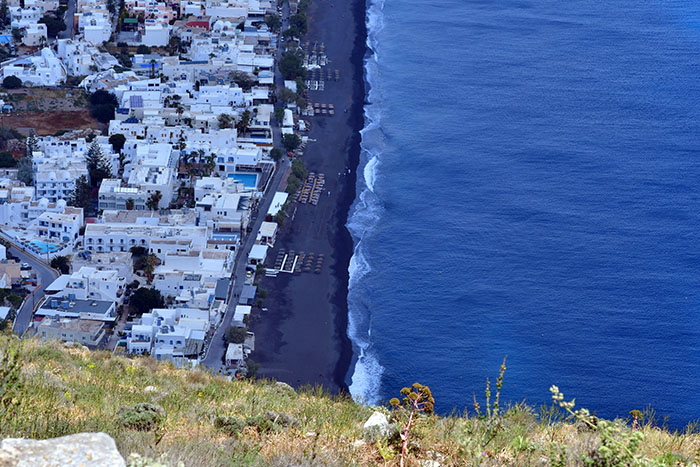
While the island has many beaches, some of them are hard to get down to. Perissa and Kamari have an easy, walk-in beaches that were quite dirty and unattractive when we visited those in late April. Many people take tours to get access to the nicest beaches. Have flip flops or shoes because the sand on the beach can be really hot during summer months since the sand is a volcanic ash, rocks and pebbles. Red Beach looks secluded between the red rocks but those rocks can be very slippery in water. Secluded and wild, the Baxedes beach is dark sand and pebbles beach. I’d suggest to open the google map and see the locations of the beaches with posted pictures for you to decide which one you want to visit. Some offer snorkeling and boat tours, others umbrellas.
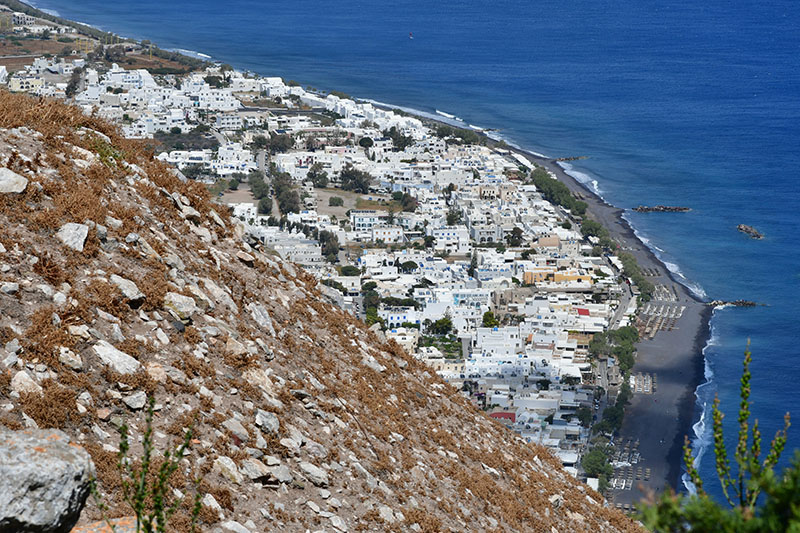
Some people also like fishing and winery tours. The tours around the caldera are popular but were canceled due to crazy weather conditions on our visit to Santorini.
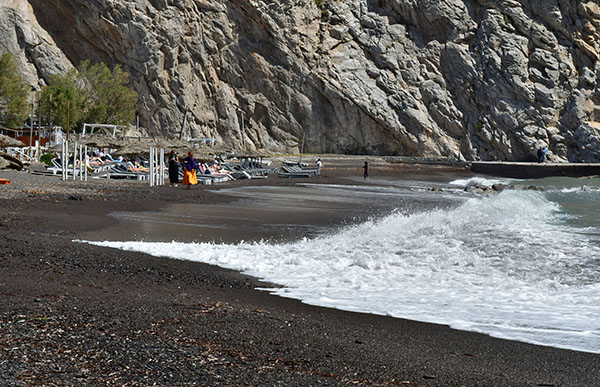
Transportation:


Take a bus all around Santorini! Its cost is just 2-2,5 euros one-way. Taxies are pricey and not worth it. The bus system is designed for tourists in mind as they have regular schedule to all main sites on the island. You buy the ticket from a driver when you enter the bus. ATV’s are inexpensive to rent for a day or more. While they can be fun for young people to drive around the island, I think they’re too much hassle for older folks. You can also rent a car to drive around the island. There were parking lots available next to sites everywhere we went to.

You can also read about the history of Greek sphinxes and Holy Meteora in Greece.
